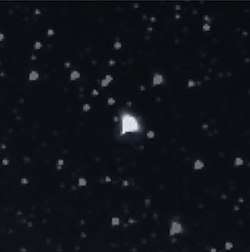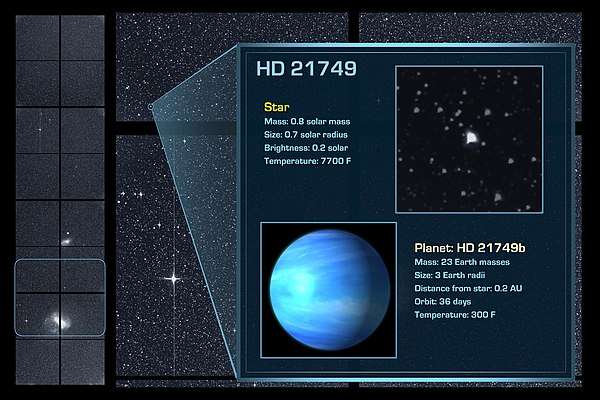HD 21749
HD 21749 (HIP 16069, 2MASS J03265922-6329569) is an orange main-sequence star[4] about 0.68 the mass of the Sun in the constellation Reticulum, located about 53 ly (16 pc) from Earth.[2] On 7 January 2019, it was announced that the star has two exoplanets: a possibly rocky, hot sub-Neptune-sized exoplanet, named HD 21749b; and, a sub-Earth exoplanet, tentatively named HD 21749c (aka, TOI-186.02).[2][6][7] These exoplanets were discovered by the Transiting Exoplanet Survey Satellite (TESS).[2]
 HD 21749 – star in the constellation Reticulum | |
| Observation data Epoch Equinox | |
|---|---|
| Constellation | Reticulum[2] |
| Right ascension | 03h 26m 59.22s[1] |
| Declination | −63° 29′ 56.9″[1] |
| Apparent magnitude (V) | 8.143[3] |
| Characteristics | |
| Spectral type | K4.5V[4] |
| Astrometry | |
| Radial velocity (Rv) | 59.46 ± 0.12[5] km/s |
| Proper motion (μ) | RA: 355.084[5] mas/yr Dec.: −247.460[5] mas/yr |
| Parallax (π) | 61.2455 ± 0.0264[5] mas |
| Distance | 53.25 ± 0.02 ly (16.328 ± 0.007 pc) |
| Details | |
| Mass | 0.68 M☉ |
| Radius | 0.76 R☉ |
| Temperature | 4571 K |
| Other designations | |
| Database references | |
| SIMBAD | data |
| Extrasolar Planets Encyclopaedia | 21749 data |
Stellar characteristics
HD 21749 is a star that is approximately 68% the mass of and 76% the radius of the Sun. It has a surface temperature of 4571 K.[1] In comparison, the Sun has a surface temperature of 5778 K.[8]
The star's apparent magnitude, or how bright it appears from Earth's perspective, is 8.143.[3]
Planetary system
HD 21749 has two known planets orbiting around it:[2] HD 21749b is a confirmed hot Neptune-sized, possibly rocky, exoplanet; and, HD 21749c is a sub-Earth-sized exoplanet.[2]
| Companion (in order from star) |
Mass | Semimajor axis (AU) |
Orbital period (days) |
Eccentricity | Inclination | Radius |
|---|---|---|---|---|---|---|
| b | 23.20 M⊕ | — | 35.6077 | — | — | 2.836 R⊕ |
| c[6][7] | ? M⊕ | 0.0695 | 7.8 | — | — | 0.892 R⊕ |

References
- Staff (2019). "Stellar Overview Page - HD 21749". NASA Exoplanet Archive. Retrieved 8 January 2019.
- Overbye, Dennis (7 January 2019). "Another Day, Another Exoplanet: NASA's TESS Keeps Counting More". The New York Times. Retrieved 8 January 2019.
- "HD 21749". SIMBAD. Centre de données astronomiques de Strasbourg. Retrieved 8 January 2018.
- Gray, R. O.; et al. (July 2006). "Contributions to the Nearby Stars (NStars) Project: spectroscopy of stars earlier than M0 within 40 pc-The Southern Sample". The Astronomical Journal. 132 (1): 161–170. arXiv:astro-ph/0603770. Bibcode:2006AJ....132..161G. doi:10.1086/504637.
- Brown, A. G. A.; et al. (Gaia collaboration) (August 2018). "Gaia Data Release 2: Summary of the contents and survey properties". Astronomy & Astrophysics. 616. A1. arXiv:1804.09365. Bibcode:2018A&A...616A...1G. doi:10.1051/0004-6361/201833051.
- Massachusetts Institute of Technology (16 April 2019). "TESS discovers its first Earth-sized planet - Orbiting a nearby star, the new planet is the smallest identified so far by the TESS mission". EurekAlert!. Retrieved 16 April 2019.
- Dragomir, Diana; et al. (15 April 2019). "TESS discovers its first Earth-sized planet - Orbiting a nearby star, the new planet is the smallest identified so far by the TESS mission" (PDF). The Astrophysical Journal Letters. 875 (2). doi:10.3847/2041-8213/ab12ed.
- Fraser Cain (15 September 2008). "Temperature of the Sun". Universe Today. Retrieved 8 January 2019.
External links
- TESS Mission – NASA.
- Reticulum Constellation at Constellation Guide
- The Deep Photographic Guide to the Constellations: Reticulum